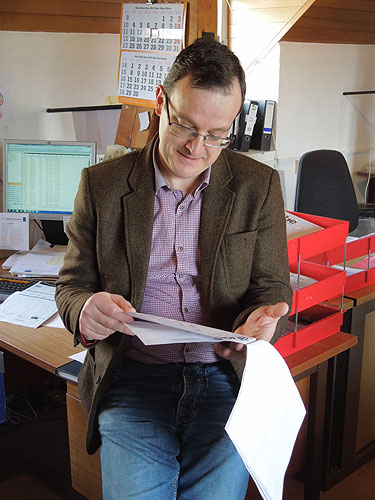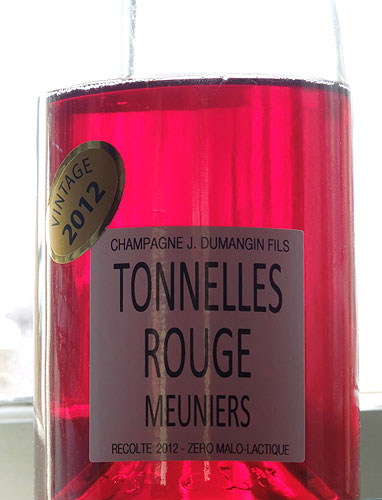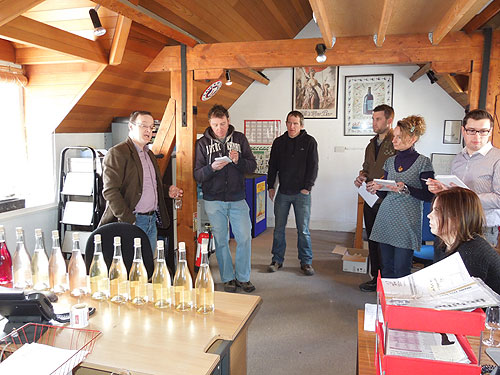We were privileged last week when our good friend Gilles Dumangin, purveyor and producer of some of the finest growers’ Champagne to found on the market, paid a visit to our H.Q. here in Mere to conduct a tasting that was both enlightening and virtually unrepeatable.

Gilles Dumangin
Gilles is 5th generation vigneron independent, based in the village of Chigny-les-Roses on the Montagne de Reims, and he has garnered a hard-earned reputation for fastidious blending, yielding wines that punch high above their modest price tags and, unsurprisingly, attract a lot of positive press attention.

Tonelles Rouge 2012
Gilles has long toyed with the notion of eliminating malolactic fermentation in his vinification process and a run of quite warm vintages, resulting in wines of relatively low acidity, has finally galvanised him to do so. For those who are not au fait with wine-making jargon malolactic fermentation is a natural process that occurs after alcoholic fermentation and involves the conversion of (citrussy) malic acids to (more creamy) lactic acids which can have a profound effect on the taste of the finished wine. Malolactic fermentation can be prevented through a painstaking combination of deploying sulphur dioxide, regulating temperature and scrupulous cellar management. Gilles explained to team Yapp that once malolactic fermentation starts in any one vat or barrel there is no putting the genie back in the bottle – it will occur throughout the cellar.

Team Yapp
To cut a long-ish story a little shorter Gilles successfully blocked the malolactic fermentation on his 2012 vintage and was keen to show us the results. He thus arrived chez Yapp with a raft of samples of the 2011 vintage, that had had a malolactic fermentation, as well as those from the corresponding grape varieties and vine parcels in the 2012 vintage that had not.

Vins Clairs
Gilles told us that in Champagne wine makers look for a high acidity in their still, base wines prior to secondary fermentation in bottle (whereby they become sparkling) as that helps give them both longevity and persistence on the palate. Coincidentally Gilles enjoyed one of his best ever harvests last year and the natural acid levels were much higher than normal anyway. This coupled with the blocked malolactic fermentation made for a marked difference between the tasting samples from the two vintages but it takes a seasoned palate to appreciate tooth-curlingly dry base wines prior to secondary fermentation and blending.

Cultivateur Gilles by David Chandler
We could tell from Gilles infectious enthusiasm and broad smile that he is delighted with the results. We have every faith in his abilities and look forward to tasting the results in five or so years time. Post tasting however, I was delighted to repair with Gilles to the Beckford Arms for a pint of reassuringly smooth and restorative Butcombe bitter – a failsafe antacid I can vouch for!
"Tight-knit, perfumed, intriguing... one of my favourite non-vintage fizzes."
Jancis Robinson MW, on Dumangin Grande Réserve Brut, in the FT Weekend.
Last weekend, myself and three colleagues had the great honour of being invited to Champagne to visit Gilles Dumangin (our man in Champagne) for the dual celebration of his 40th Birthday and 10th Anniversary of taking over the reins of the family business from his father, Jacky, at J.Dumangin Fils. Although I have been lucky enough to visit Champagne on several occasions, this was my first visit to see Gilles and the village of Chigny-les-Roses.
The festivities kicked off on Saturday at 1pm with an extensive tour of the winery, with Gilles ably alternating between French and English for his diverse audience. There were 30 or so of us in total, hailing from far and wide. Gilles' champagnes have rightly garnered plaudits from around the world and this was reflected with his guests. As well as a fair few French and Brits, including journalist and respected authority on Champagne Tom Stevenson , there were also Dumangin enthusiasts from Belgium, Poland, Lithuania and South Africa.
Following the tour we all assembled in the press and tank room to start some serious work - a potentially daunting, and certainly impressive tasting of 20 Dumangin vintages from Gilles private cellars, ranging from his soon to be available 2004 back to 1982, a time when I still thought R. Whites lemonade was the be all and end all of all things sparkling.
Needless to say, this tasting (quite rightly) took some time and it was fascinating to see how the vintages varied and developed over time. My personal stand out vintages on the day were:- 2002, 1994, 1990 and 1982. Those followers of the 'beautiful' game will note that these dates coincide with the Coup du Monde, a strange coincidence? Certainly a useful aide memoire for recommending his vintages. It is a pity that the England team have never shown as well in these years!
It is amazing how time flies when one is immersed in Champagne and it was about 5.30pm when Gilles ushered us out into the still bright sunlight of day, in order that he and his team could convert the winery into a pop up dining room for the evening grand finale. We popped back to our B&B in the neighbouring village, where we found a bottle of Champagne waiting for us from our genial landlady. A lovely gesture, that was possibly treated a tad flippantly by us, having being spoilt all afternoon with glass after glass of the stuff. How quickly we are corrupted!
We returned chez Dumangin around 7.30pm. As well as fellow tasters from the afternoon, we were now joined by another 20 or so guests, including Gilles' delightful family. Ever the showman, our host produced a Nebuchadnezzar (15 litres or 20 standard bottles) of his 2002 vintage which he deftly opened and poured for his guests. Delicious hors d'oeuvres began to filter out from the field kitchen that had been assembled in the Dumangin office. It took a good couple of hours or so for the assembled guests to finish the monster bottle and for the chef to open the cellar doors and beckon us in for dinner.
The warehouse and bottling room where we had originally assembled in what seemed an age ago had been transformed with the deft use of strategic lighting and beautifully dressed tables, into a dining hall worthy of the food and champagne that was to follow.
Gilles had employed the services of Chef Thierry Landragin from the Restaurant de l'Abbaye in Hautvilliers for the evening, and his food was excellent. Each course was accompanied by a magnum of Champagne for each table, each one specially selected to match the food. My favourite course was the Truite saumonée sur lit d'avoine au Ratafia & Médaillon de Homard which was served with some Dumangin vintage 2000. Not a world cup year, but still a perfect match for this Lobster and risotto fish dish.
Although wistful when our taxi arrived around 2am, it had been a very long day, and I think that we were all ready for our beds as we departed. It had been an amazing evening and a weekend that I will treasure for a long time. Any pangs of sorrow about it all being over and being back at work in the UK, have been tempered as an email has arrived from Gilles forewarning us to keep a weekend free in 2021, when he plans to celebrate his 50th with what will then be a tasting 26-27 vintages plus a couple more Nebuchadnezzars... Now where's my ten year diary...
Designed by Inigo Jones for James I and being the last building that Charles I walked through to his execution on the scaffold outside, Whitehall's Banqueting House is steeped in history. The surroundings of the Main Hall are truly majestic, with a Rubens painted ceiling looking down over proceedings below it is perhaps apt that in more recent years, this has been the home for The Champagne Bureau's Annual March Tasting.
With over 70 producers in attendance and each one showing a selection of three champagnes, it is thought to be the largest Champagne tasting in the world. It is certainly always much anticipated and well attended. This year I was helping 'our man in Champagne', Gilles Dumangin, present his wares to the great and the good of the UK Wine Trade; the wine journalists, the bloggers, fellow merchants, sommeliers and anyone else who could get their hands on a ticket. It is ironic that this is the event that all the Champenois look forward to travelling to as it is the only time that they get to try each other's wines on such a scale!
The current economic situation had done nothing to dampen people's enthusiasm and this is reflected in the fact that although imports have dropped in the U.K., we are still the largest importer of Champagne in the world. It is when people are more considered with their spending that it becomes even more important to make sure that what is available is of good quality and value.
Once again, out of the champagne that I had a chance to try, it was the Grower champagnes that stood out best. When up to 50% of the retail price of a 'Grand Marque' champagne can go towards marketing and promotion, it is little wonder that the actual product can often fail to live up to the price tag. This made it all the more refreshing that our Dumangin range was so well received on the day. Indeed, it was interesting to see how quickly our Grande Reserve NV was consumed by fellow merchants at the exhibitors' lunch in the vaults below. Every exhibitor had donated two bottles each for the lunch and by the time I made it downstairs for a bite, the Grande Reserve had long gone!
Gilles is proper récoltant manipulant (a wine-maker producing wine from their own vine holdings) based at Chigny-les-Roses on the Montagne de Reims - as was his great great grandfather Hippolyte Dumangin the first of his forebears to bottle his own wine. The three champagnes that we were showing were:- Brut Grand Réserve Premier Cru NV, a rich, full flavoured champagne with delightful toasted notes and elegant, smooth finish ; Brut Premier Cru Millésime 2000, a corking vintage which is just coming into its own. Great structure with great balance of mineral, citrus and delicate fruit. Long refreshing finish that leaves you wanting more! (£30.75); Brut Rosé Premier Cru NV, mouth-filling berry flavours, well balanced with crisp, developed finish .
Following an extensive and extremely informative morning tasting of J Dumangin Fils Champagnes, some colleagues and I entertained Gilles Dumangin to lunch at the beautiful Howard's House Hotel in the quaint Wiltshire village of Teffont Evias. Neither the village nor the hotel could have looked more stunning on such a glorious Spring day and I felt sure we would be in for a most enjoyable interlude.
Our attentive host, Noele Thompson, brought the menus to us in a comfortable ante-room and, while we made our choices from the short but wonderfully varied menu, we were delighted to hear another party of diners ordering a bottle of Gilles' Grand Réserve Champagne. Deciding, though, that we had had our fill of Champagne for one day, we ordered a bottle of 2007 Vouvray Sec from Domaine Champolou which pleased everyone and, with subtle honey nuances that made it seem almost off-dry, it was a sublime pairing with my starter of Twice-Baked Blue Cheese Soufflé with a walnut and poached pear salad. There was much praise from my colleagues for their starters too and these included a Leek Risotto topped with breast of local pigeon and Home Cured Salmon with a smoked salmon mousse.
The dining room at Howard's House is small and well-appointed and looks out onto the walled garden and terrace. Both made an idyllic picture in the sunshine and I could see why the hotel is a popular venue for weddings. Chef Nick Wentworth's ethos is to cook simply with the very best of predominantly local ingredients which are sourced from the hotel's own potager garden and from a stable of impressive local suppliers and we could certainly see this theme coming to life at our table.
Our main courses arrived with appropriate timing and were as exquisitely presented as the starters. I plumped for Braised Blade of Devon Ruby Red Beef with a root vegetable purée, spinach and confit shallot and I couldn't have been happier with my choice. The beef was cooked to perfection, the texture of the meat being almost like a Boeuf Bourgignon - meltingly tender and rich. My fellow diners reported a Fillet of Wild Halibut with fondant potato, baby asparagus and a brown shrimp dressing to be full of flavour and beautifully cooked and the Roasted Tenderloin and Confit Belly of Pork with a wholegrain mustard mash and calvados sauce both looked and smelled divine. A bottle of Côtes du Rhône Saint Gayan, from the superb 2007 vintage, accompanied our main course and it was extraordinarily good with the beef.
As decadent and delicious as the desserts sounded, and I was sorely tempted by Rhubarb Crumble with Dorset clotted cream, we all decided to go straight for coffee, choosing a mixture of double and single espressos. When they were brought to the table, each cup looked to have exactly the same measure but, by this time, no-one really cared and the coffee itself was as strong and flavourful as a good espresso should be.
All in all, this had been a most delicious and convivial lunch. In fact I can't remember one so good in a long time. I was keen to hear that a new dining terrace opens in the garden on 1st May and I have made a mental note to return on a sunny summer's day to partake of a relaxed al fresco lunch with friends.








